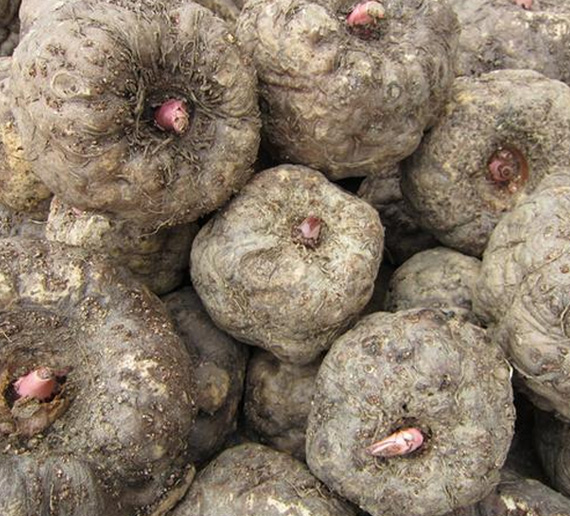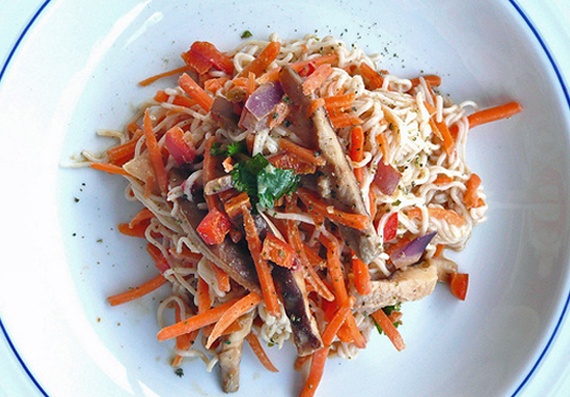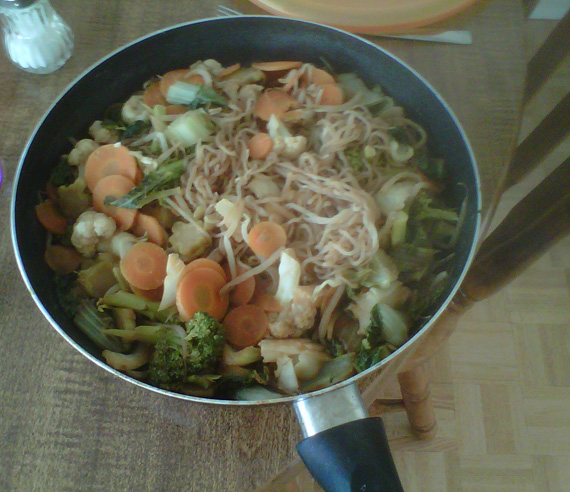
Konjac is a perennial herb; with the Greek name of Araceae and Genus Amorphophallus. Most of the Konjac plant grows in subtropical mountainous or hilly areas with an altitude of 800 meters and an average temperature of 16°C. Such prime geographic location and altitude makes the Glucomannan in the Konjac very high and pure. Its air, soil, and water are essentially not polluted, so the products can meet the requirements of green foods.
Konjac is mainly distributed in Southeast Asia and Africa, as there is no planting record in America and Europe. In production and scale, Konjac is mainly distributed in China, Japan, Myanmar, Vietnam, Indonesia and other Asian countries.
The edible part of Konjac is its swollen underground flat round tuber. Its width is over 25 cm in diameter. It is cylindrical, light green, with dark purple stains, and palmate compound leaf. It has stout petiole and grows in sparse woods. Konjac is highly nutritious, with over 45% of Glucomannan,9.7% of crude protein,16 different kinds of amino acids up to 7.8%, 7 essential amino acids up to 2.5%.It contains minerals such as calcium, phosphorus, iron ,zinc, manganese, chromium and copper and is low calorie, low fat and high in fiber.
Its dietary fiber is easily absorbed; it is the best and the most secure form of soluble dietary fiber provided by nature to humans. The glucomannan in konjac cannot get hydrolyzed by the digestive enzymes in the digestive organs, therefore one cannot produce calories by consuming this food. Dietary fiber has irreplaceable physiological function in the human body, which prevents the body from harm of many diseases. Americans call it the, "life saving food for the westerners to diseases of civilization." The Japanese call it "blood purification," as well as "an intestinal scavenger."
Konjac can stimulate absorption and digestion of protein and other nutritious substances, keeps the intestine clean, and assists in bowel movement. It can balance the diet, relieve fatigue, and it has the function of keeping one fit and preventing cancer. So, in recent years it has become quite popular around the world, and is labeled "magic food," "amazing food," "healthy food"etc.
The main chemical components in konjac tuber
Knonjac has unique nutritional properties. In every 100 grams of konjac tuber, there are 50 grams of Glucomannan, glucose fructose, and sucrose. Every 100 grams of konjac flour contains 1.64g protein, 0.004g fat, 57mg phosphorus, 4.06mg iron, 123mg zinc, 0.2mg manganese, 0.25chromium, 0.08mg copper and 79.37mg glucomannan.
Glucomannan is a high-molecular compound, which is super absorbent; its size expands by 80-100xs after absorbing water and swelling. It cannot be easily digested and absorbed after eating, but can absorb cholesterol and bile acid, and has certain functions of reducing high blood pressure and cardiovascular diseases.
Protein and amino acids
Konjac tuber contains 5%-10% crude protein and 6.8%-8.0% of 16 amino acids (including 7 essential amino acids.) Amorphophallus konjac has 18 amino acids equivalent to 6.283%, with the most essential amino acids consisting of 2.634%, and white konjac contains amino acids of 5.14% and 2.137%.
Minerals
Konjac contains many minerals; konjac tuber contains a high content of K、Ca、Mg、Fe、Mn、Cu、Co According to reports by Cuixi, it is necessary for the body to trace elements and constant elements are high in konjac.
Soluble dietary fiber
Dietary fiber is composed of edible plant ingredients, carbohydrates and other similar substances, which can be absorbed and digested by the intestine. Dietary fiber is absorbed with the assistance of polysaccharides, oligosaccharides, lignin and other plant substances through a process that occurs during fermentation through the intestine. Dietary fiber is a necessary ingredient for one's health.
Soluble dietary fiber (SDF) includes mainly pectin and hydrocolloid substances, as ell as hemicelluloses, gum, pectin, algin, bean gum, agar and CMC. Soluble dietary fiber is incredibly adhesive, thus it can form a protective screen in the surface of the intestine. As a result, it can bind together the molecules of cholesterol, which in turn allows konjac fiber to be the best soluble dietary fiber; due to its Glucomannan content. It cannot be digested in the stomach and it is quite healthy. It has comprehensive effects to the human body and can prevent many chronic diseases by regulating the metabolism. Lycerides prevent the absorption through the intestine, so konjac can aid in losing weight, lowering blood pressure, lipids, glucose and cholesterol.

Prevention of cardiovascular and cerebrovascular diseases
Cholesterol is an important fat-like substance found in the human body, (it is a fat-like substance in the blood as well, bile also has cholesterol,) that can add more risks of getting coronary heart disease and stone disease. Dietary fiber in the human body can effectively adsorb cholesterol and bile acid, and can inhibit the absorption of cholesterol and bile acid through the intestine, stimulate bile excretion, reduce the amount of cholesterol and prevent coronary heart disease and stroke.
Konjac is an alkaline food.
Konjac is a beneficial alkaline food. It is particularly beneficial to those who eat many acidic foods of animals, if konjac is regularly consumed in their diets, acid-base balance can be achieved. Consequently, Konjac
Beneficial to one's health- Konjac food is not only delicious, tasteful, but also has the function of keeping one fit and preventing cancer.
Prevent cancer- Konjac can suspend the metabolism of cancer cells prevention. Susceptibility testing indicates it is sensitive to cardiovascular and the colon cancer cell. It can clean sputum, soften hard cells, break up bumps and detoxicate.It can cure mass, sputum nuclear, M.scrofulaceum and prevent cancer.
Lubricate intestine and reduce fat absorption. The fiber in konjac can stimulate the intestine and stomach, lubricate the intestine, prevent constipation, and reduce fat absorption. In addition, it is good for the treatment of bowel disease; it can reduce the accumulation of cholesterol, and is quite substantial in prevention of high blood pressure and coronary arteriosclerosis.
Weight loss. Konjac is a low-calorie food. The glucomannan in konjac can absorb water and enlarge up to 30-100xs than the original size. After eating, one may feel quite full. It can be used in curing diabetes, and is the ideal diet food.
Everyone can eat konjac, especially diabetic patients and those who face challenges with obesity.

Chronic functional (habitual) constipation is very common. A British investigation indicated that 10% of the population was plagued by this disease, the incidence increases with age, 3% in the young to 20% in the old; other developed countries had comparable figures as well. Patients with constipation get worse with age and consuming refined foods. Ambulatory patients that suffer from acute diseases (cerebral vascular accident, heart failure, pulmonary failure, and renal failure) have constipation. Maintaining good circulation in the intestine is the essential treatment to help those with acute diseases.
To prevent constipation, dietary fiber should be added in one's diet. Coarse grains, vegetables, fruits and konjac flour product are rich sources of dietary fiber. The dietary fiber absorbs water, enlarges stool volume, improves intestinal flora (the bacteria in intestine ferment the dietary fiber to yield lower fatty acids), and stimulates peristalsis. These are all good for defecation.
For patients with constipation, there are currently five kinds of laxatives clinically available: lubrication, ease, salts, force and volume. These four types of laxatives need to be carefully used. However, fiber assists in enlarging the stool volume. This creates fiber that is of 0 caloric value, so one can control their weight without dieting, and have the ability to lose weight naturally.
Other forms of dietary fiber can slow down the absorption of nutrients. Unlike other forms of dietary fiber, Konjac dietary fiber, as a soluble form can outline a protective layer around the food to prevent digestive enzymes from interacting with food. Therefore, this stops the absorption of glucose and prevents nutrients from turning into calories. Konjac dietary fiber sweeps the waste of the intestine, reduces the amount and caloric food intake, and it can also take away the excess fat and energy. This concept can be verified by testing the fat content in the stool.
If an overweight patient chooses dietary fiber food, they can not only lose weight easily, but also blood sugar and lipids can be reduced, and the chance of getting atherosclerosis is decreased.
Prevention of cardiovascular and cerebrovascular diseases
Coronary heart disease has already become one of the biggest killers of human beings. Lipid metabolism will undoubtedly speed up the process of atherosclerosis. A large number of epidemiological investigations and experimental researches confirmed that plasma cholesterol levels are highly related to atherosclerosis and coronary heart disease. An U.S survey shows that, over 50% of the elderly populations have higher blood cholesterol, which is a risk factor for coronary heart disease. In the study, if cholesterol levels were reduced by 1%, coronary heart disease risk was reduced by 2 %. The soluble dietary fiber in konjac can increase bile acid excretion and bile acid synthesis by interacting with bile acid. Accordingly, the study's results indicated that cholesterol levels can be reduced, can decrease the cancer possibilities brought by acid metabolites, and can reduce the gallstone possibilities brought by accumulations of biliary excretion.
Glucomannan can effectively inhibit the absorption of cholesterol and bile acid through lipolysis through the intestine, promote fat excretion, reduce the amount of fat and cholesterol in the blood, and reduce the amount of cholesterol and triglyceride in serum. It can also prevent high blood pressure, high lipids, and other cardiovascular diseases.
The soluble dietary fiber in konjac can increase bile acid excretion and bile acid synthesis by interacting with bile acid, so that cholesterol levels can be reduced. The SDF in Konjac can reduce cancer possibilities by acid metabolites and reduce the gallstone formation due to the accumulations of biliary excretion. According to experiments studied, insoluble crude fiber has no effect of reducing lipids, only soluble fiber has the effect of reducing lipids. Konjac can notably reduce blood cholesterol and triglyceride levels. Once lipid reaches to the normal level it will not get lower. Thus, konjac can regulate lipid metabolism and prevent hyperlimpidemia.
Regulate immune system
Non-starch polysaccharides have the function of regulating the immune system and can strengthen one part or several parts in non-specific immune; cellular immune and humeral immune. Preliminary studies indicate that konjac flour has immunoregulatory activity.
Natural antibiotics
Konjac has a rare kind of natural antibiotic. It can form antibacterial film at the surface of the food which is made from konjac flour, (the main material and other materials) so that it can prevent bacterial invasion, extend the storage time and play the role of antibiotics and preservation.
Preferred Calcium Supplement
As natural plant, 100 grams of konjac product contains 43 mg of calcium. The calcium in konjac food can be easily washed out; it washes especially when the wash out rate is much higher in acid solution. When konjac is consumed, the chewed konjac then interacts with the acid gastric juice, and calcium begins to dissolve, which in turn becomes absorbed by stomach and intestine, so that calcium can be supplemented.
Chinese konjac was exported to Japan 1000 years ago. In the beginning, it was a precious gift between monks in the form of medicine and cakes. When the Japanese administration of Kamakura came into office, it became the popular food. Konjac is quite popular in Japan; almost every family eats Konjac in every meal. Even today it is still the most favored food in Japan. The Ministry of Health in Japan implemented that konjac food should be used in the cafeteria for all schools. Right now, Japan is the biggest country in consuming konjac food. Konjac was listed as one of the top ten healthiest foods by World Health Organization.
Copyright © 2002 ~ 2017 KonjacFoods.com